Analyzing Intellectual Property Rights in Singapore: A Case Study
VerifiedAdded on 2020/03/13
|8
|1631
|94
Essay
AI Summary
This essay provides a comprehensive overview of intellectual property rights (IPR) in Singapore, focusing on copyright and patent law. It defines IPR as exclusive rights granted for human creations and outlines the legal framework for registration, including patents, copyrights, and trademarks. The essay examines the types of interests protected by Singapore's IP framework, detailing legal requirements for copyright (originality, material form, connection to Singapore or Berne Union/WTO) and patents (novelty, inventive step, industrial application). A case study involving an independent film producer, John, who creates a film based on a TV series, is used to illustrate issues of copyright infringement, patent infringement (special effects), and the measures John could take, such as obtaining licenses. The essay also discusses appropriate legal structures for offering rights to investors, including licensing (exclusive and non-exclusive) and transfer of ownership. The conclusion summarizes the key points related to IPR, including the legal requirements, infringement, and consequences, and offers a view on legal structures. References to relevant case laws and legislation, such as the Copyright Act and Patent Act, are provided to support the arguments.
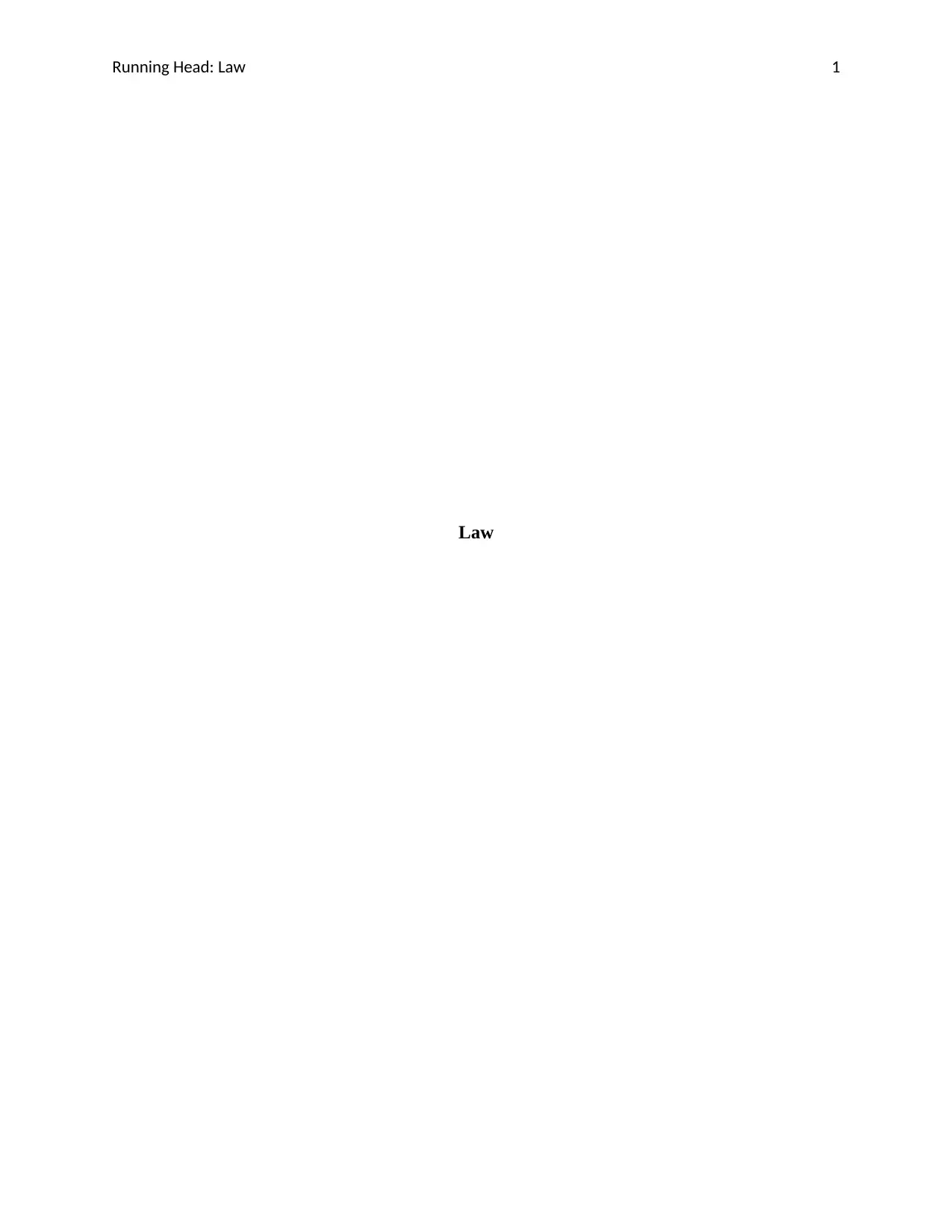
Running Head: Law 1
Law
Law
Paraphrase This Document
Need a fresh take? Get an instant paraphrase of this document with our AI Paraphraser
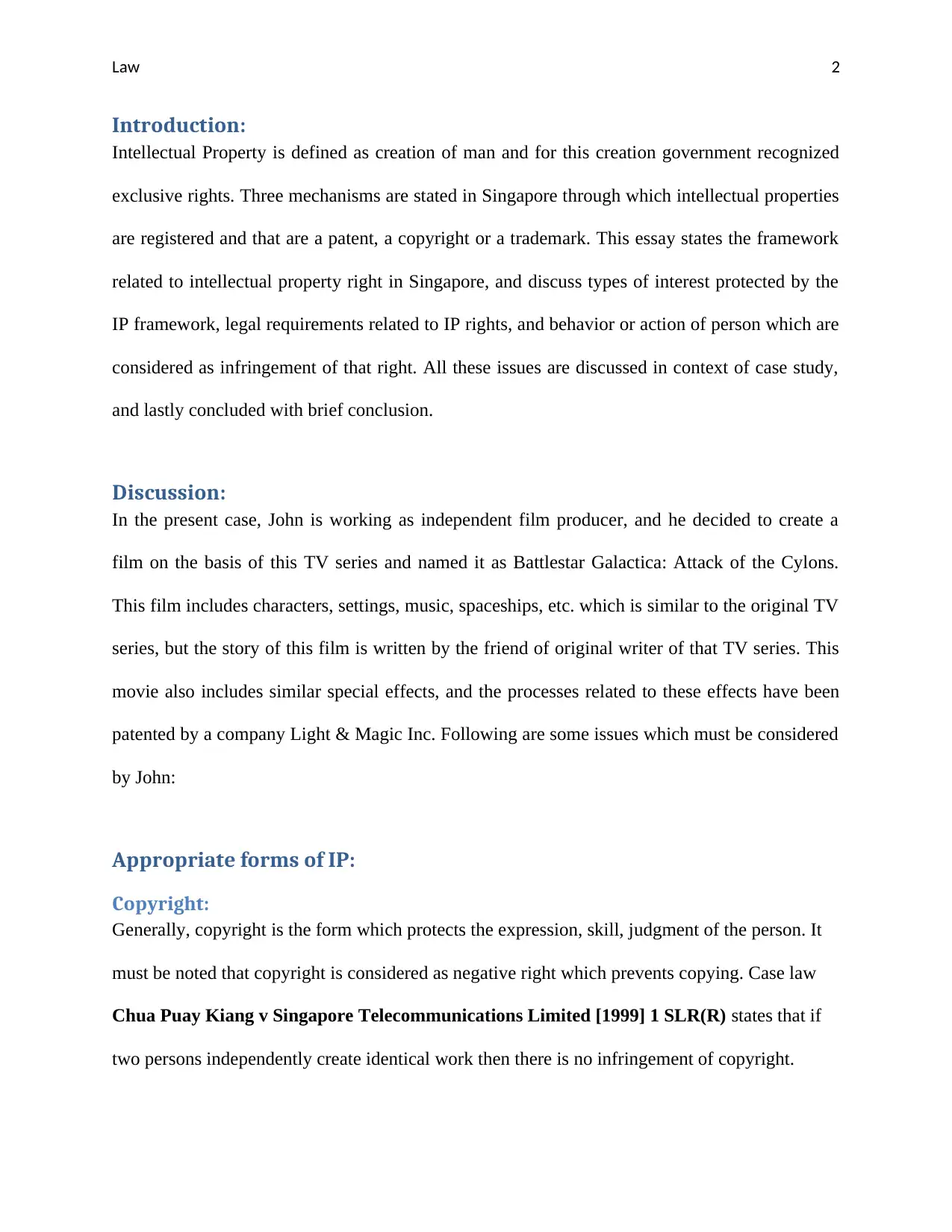
Law 2
Introduction:
Intellectual Property is defined as creation of man and for this creation government recognized
exclusive rights. Three mechanisms are stated in Singapore through which intellectual properties
are registered and that are a patent, a copyright or a trademark. This essay states the framework
related to intellectual property right in Singapore, and discuss types of interest protected by the
IP framework, legal requirements related to IP rights, and behavior or action of person which are
considered as infringement of that right. All these issues are discussed in context of case study,
and lastly concluded with brief conclusion.
Discussion:
In the present case, John is working as independent film producer, and he decided to create a
film on the basis of this TV series and named it as Battlestar Galactica: Attack of the Cylons.
This film includes characters, settings, music, spaceships, etc. which is similar to the original TV
series, but the story of this film is written by the friend of original writer of that TV series. This
movie also includes similar special effects, and the processes related to these effects have been
patented by a company Light & Magic Inc. Following are some issues which must be considered
by John:
Appropriate forms of IP:
Copyright:
Generally, copyright is the form which protects the expression, skill, judgment of the person. It
must be noted that copyright is considered as negative right which prevents copying. Case law
Chua Puay Kiang v Singapore Telecommunications Limited [1999] 1 SLR(R) states that if
two persons independently create identical work then there is no infringement of copyright.
Introduction:
Intellectual Property is defined as creation of man and for this creation government recognized
exclusive rights. Three mechanisms are stated in Singapore through which intellectual properties
are registered and that are a patent, a copyright or a trademark. This essay states the framework
related to intellectual property right in Singapore, and discuss types of interest protected by the
IP framework, legal requirements related to IP rights, and behavior or action of person which are
considered as infringement of that right. All these issues are discussed in context of case study,
and lastly concluded with brief conclusion.
Discussion:
In the present case, John is working as independent film producer, and he decided to create a
film on the basis of this TV series and named it as Battlestar Galactica: Attack of the Cylons.
This film includes characters, settings, music, spaceships, etc. which is similar to the original TV
series, but the story of this film is written by the friend of original writer of that TV series. This
movie also includes similar special effects, and the processes related to these effects have been
patented by a company Light & Magic Inc. Following are some issues which must be considered
by John:
Appropriate forms of IP:
Copyright:
Generally, copyright is the form which protects the expression, skill, judgment of the person. It
must be noted that copyright is considered as negative right which prevents copying. Case law
Chua Puay Kiang v Singapore Telecommunications Limited [1999] 1 SLR(R) states that if
two persons independently create identical work then there is no infringement of copyright.
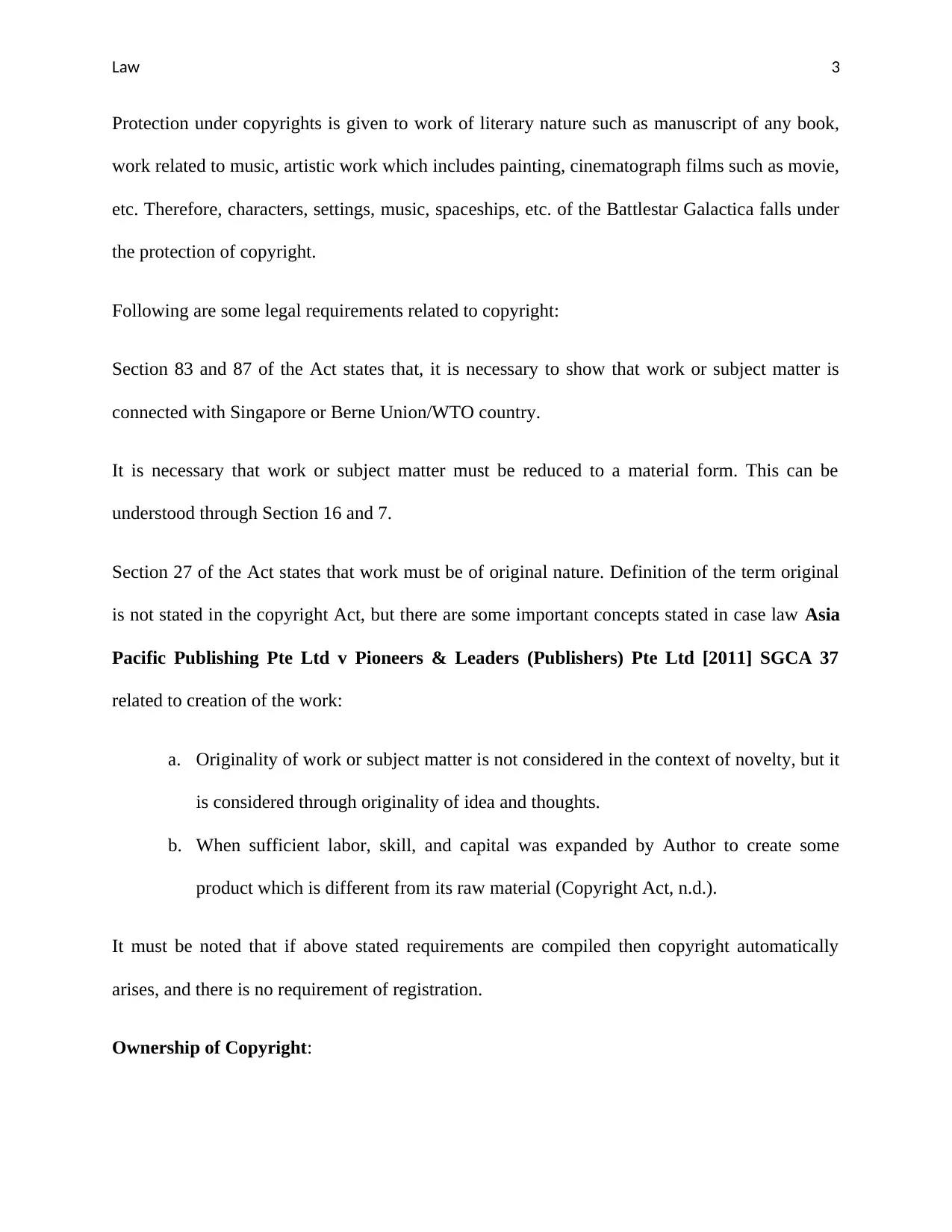
Law 3
Protection under copyrights is given to work of literary nature such as manuscript of any book,
work related to music, artistic work which includes painting, cinematograph films such as movie,
etc. Therefore, characters, settings, music, spaceships, etc. of the Battlestar Galactica falls under
the protection of copyright.
Following are some legal requirements related to copyright:
Section 83 and 87 of the Act states that, it is necessary to show that work or subject matter is
connected with Singapore or Berne Union/WTO country.
It is necessary that work or subject matter must be reduced to a material form. This can be
understood through Section 16 and 7.
Section 27 of the Act states that work must be of original nature. Definition of the term original
is not stated in the copyright Act, but there are some important concepts stated in case law Asia
Pacific Publishing Pte Ltd v Pioneers & Leaders (Publishers) Pte Ltd [2011] SGCA 37
related to creation of the work:
a. Originality of work or subject matter is not considered in the context of novelty, but it
is considered through originality of idea and thoughts.
b. When sufficient labor, skill, and capital was expanded by Author to create some
product which is different from its raw material (Copyright Act, n.d.).
It must be noted that if above stated requirements are compiled then copyright automatically
arises, and there is no requirement of registration.
Ownership of Copyright:
Protection under copyrights is given to work of literary nature such as manuscript of any book,
work related to music, artistic work which includes painting, cinematograph films such as movie,
etc. Therefore, characters, settings, music, spaceships, etc. of the Battlestar Galactica falls under
the protection of copyright.
Following are some legal requirements related to copyright:
Section 83 and 87 of the Act states that, it is necessary to show that work or subject matter is
connected with Singapore or Berne Union/WTO country.
It is necessary that work or subject matter must be reduced to a material form. This can be
understood through Section 16 and 7.
Section 27 of the Act states that work must be of original nature. Definition of the term original
is not stated in the copyright Act, but there are some important concepts stated in case law Asia
Pacific Publishing Pte Ltd v Pioneers & Leaders (Publishers) Pte Ltd [2011] SGCA 37
related to creation of the work:
a. Originality of work or subject matter is not considered in the context of novelty, but it
is considered through originality of idea and thoughts.
b. When sufficient labor, skill, and capital was expanded by Author to create some
product which is different from its raw material (Copyright Act, n.d.).
It must be noted that if above stated requirements are compiled then copyright automatically
arises, and there is no requirement of registration.
Ownership of Copyright:
⊘ This is a preview!⊘
Do you want full access?
Subscribe today to unlock all pages.

Trusted by 1+ million students worldwide
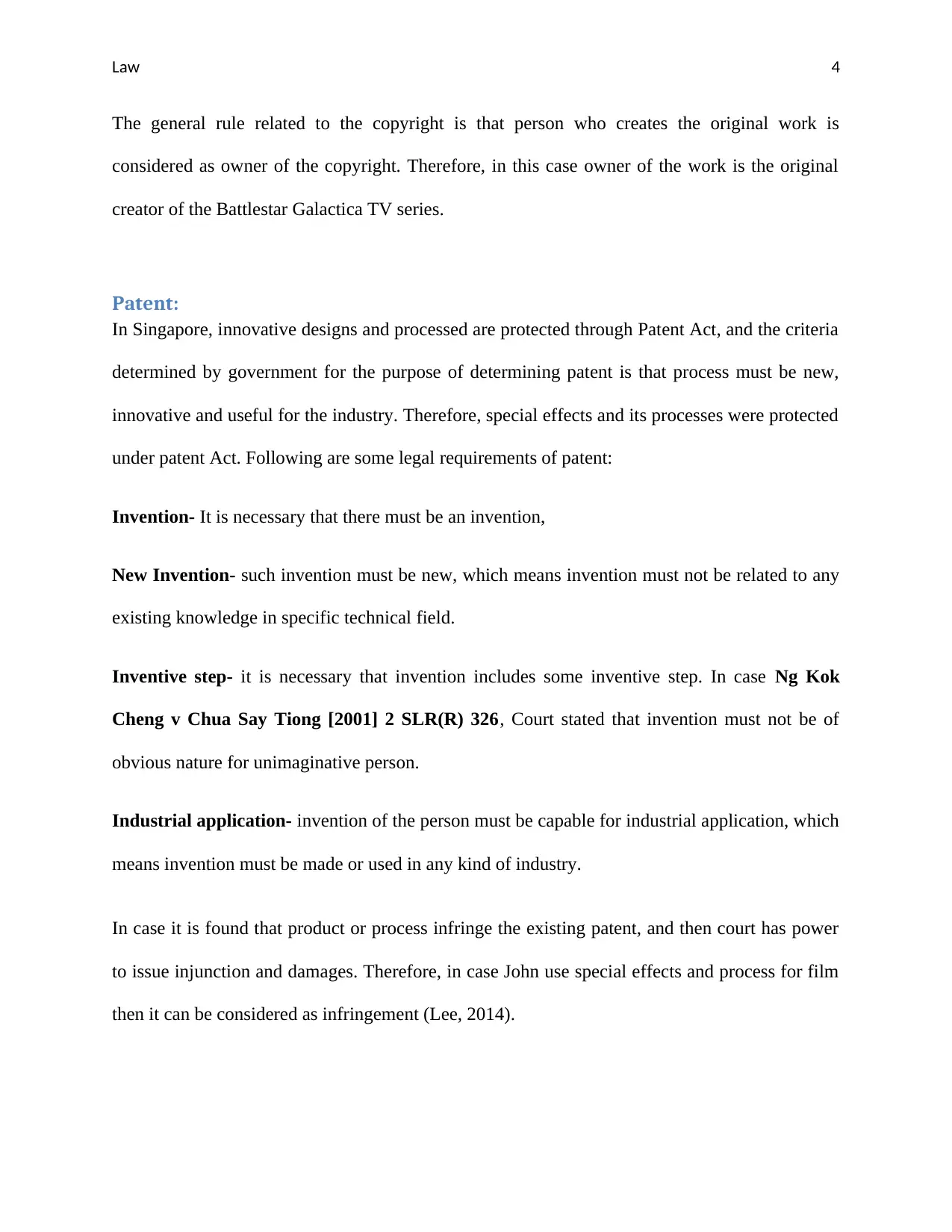
Law 4
The general rule related to the copyright is that person who creates the original work is
considered as owner of the copyright. Therefore, in this case owner of the work is the original
creator of the Battlestar Galactica TV series.
Patent:
In Singapore, innovative designs and processed are protected through Patent Act, and the criteria
determined by government for the purpose of determining patent is that process must be new,
innovative and useful for the industry. Therefore, special effects and its processes were protected
under patent Act. Following are some legal requirements of patent:
Invention- It is necessary that there must be an invention,
New Invention- such invention must be new, which means invention must not be related to any
existing knowledge in specific technical field.
Inventive step- it is necessary that invention includes some inventive step. In case Ng Kok
Cheng v Chua Say Tiong [2001] 2 SLR(R) 326, Court stated that invention must not be of
obvious nature for unimaginative person.
Industrial application- invention of the person must be capable for industrial application, which
means invention must be made or used in any kind of industry.
In case it is found that product or process infringe the existing patent, and then court has power
to issue injunction and damages. Therefore, in case John use special effects and process for film
then it can be considered as infringement (Lee, 2014).
The general rule related to the copyright is that person who creates the original work is
considered as owner of the copyright. Therefore, in this case owner of the work is the original
creator of the Battlestar Galactica TV series.
Patent:
In Singapore, innovative designs and processed are protected through Patent Act, and the criteria
determined by government for the purpose of determining patent is that process must be new,
innovative and useful for the industry. Therefore, special effects and its processes were protected
under patent Act. Following are some legal requirements of patent:
Invention- It is necessary that there must be an invention,
New Invention- such invention must be new, which means invention must not be related to any
existing knowledge in specific technical field.
Inventive step- it is necessary that invention includes some inventive step. In case Ng Kok
Cheng v Chua Say Tiong [2001] 2 SLR(R) 326, Court stated that invention must not be of
obvious nature for unimaginative person.
Industrial application- invention of the person must be capable for industrial application, which
means invention must be made or used in any kind of industry.
In case it is found that product or process infringe the existing patent, and then court has power
to issue injunction and damages. Therefore, in case John use special effects and process for film
then it can be considered as infringement (Lee, 2014).
Paraphrase This Document
Need a fresh take? Get an instant paraphrase of this document with our AI Paraphraser
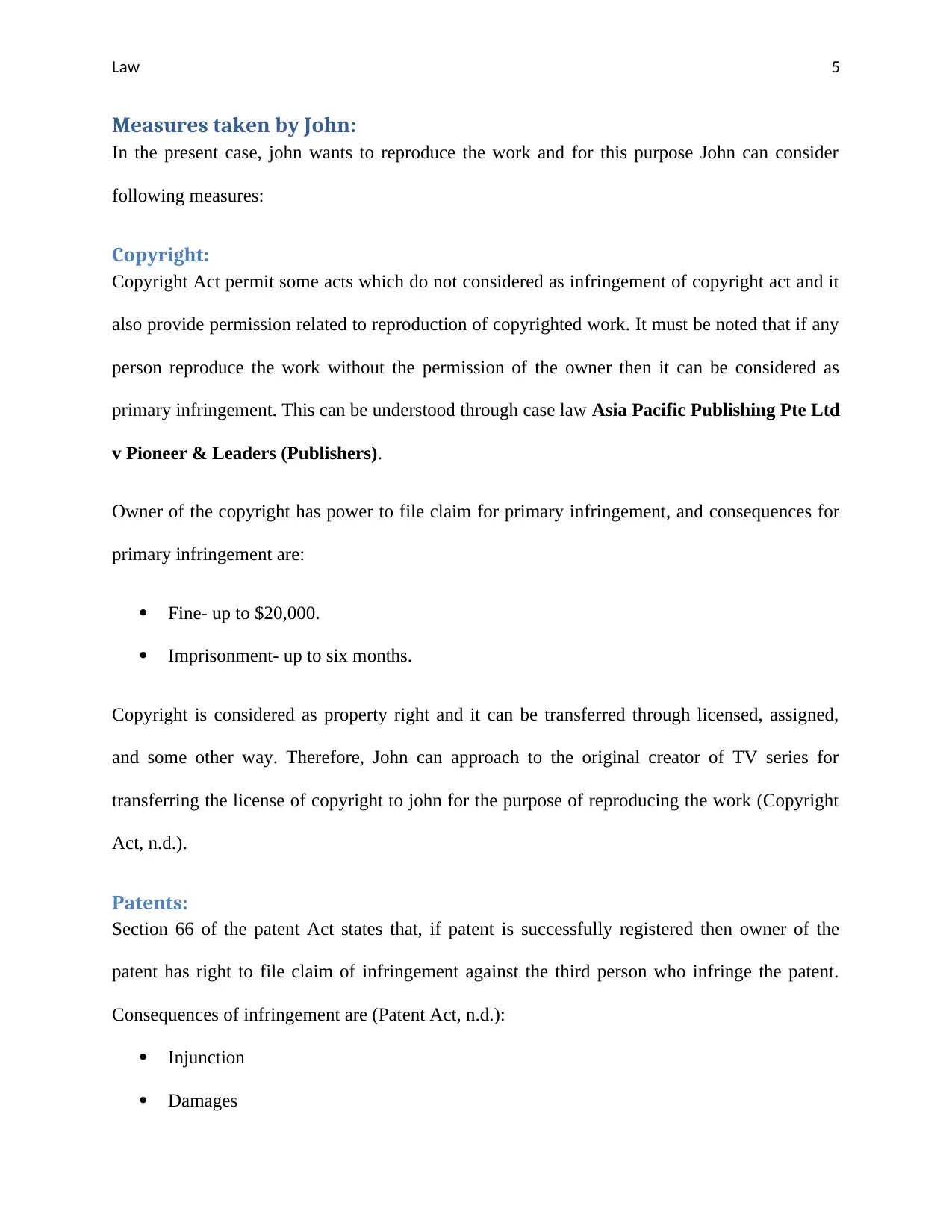
Law 5
Measures taken by John:
In the present case, john wants to reproduce the work and for this purpose John can consider
following measures:
Copyright:
Copyright Act permit some acts which do not considered as infringement of copyright act and it
also provide permission related to reproduction of copyrighted work. It must be noted that if any
person reproduce the work without the permission of the owner then it can be considered as
primary infringement. This can be understood through case law Asia Pacific Publishing Pte Ltd
v Pioneer & Leaders (Publishers).
Owner of the copyright has power to file claim for primary infringement, and consequences for
primary infringement are:
Fine- up to $20,000.
Imprisonment- up to six months.
Copyright is considered as property right and it can be transferred through licensed, assigned,
and some other way. Therefore, John can approach to the original creator of TV series for
transferring the license of copyright to john for the purpose of reproducing the work (Copyright
Act, n.d.).
Patents:
Section 66 of the patent Act states that, if patent is successfully registered then owner of the
patent has right to file claim of infringement against the third person who infringe the patent.
Consequences of infringement are (Patent Act, n.d.):
Injunction
Damages
Measures taken by John:
In the present case, john wants to reproduce the work and for this purpose John can consider
following measures:
Copyright:
Copyright Act permit some acts which do not considered as infringement of copyright act and it
also provide permission related to reproduction of copyrighted work. It must be noted that if any
person reproduce the work without the permission of the owner then it can be considered as
primary infringement. This can be understood through case law Asia Pacific Publishing Pte Ltd
v Pioneer & Leaders (Publishers).
Owner of the copyright has power to file claim for primary infringement, and consequences for
primary infringement are:
Fine- up to $20,000.
Imprisonment- up to six months.
Copyright is considered as property right and it can be transferred through licensed, assigned,
and some other way. Therefore, John can approach to the original creator of TV series for
transferring the license of copyright to john for the purpose of reproducing the work (Copyright
Act, n.d.).
Patents:
Section 66 of the patent Act states that, if patent is successfully registered then owner of the
patent has right to file claim of infringement against the third person who infringe the patent.
Consequences of infringement are (Patent Act, n.d.):
Injunction
Damages
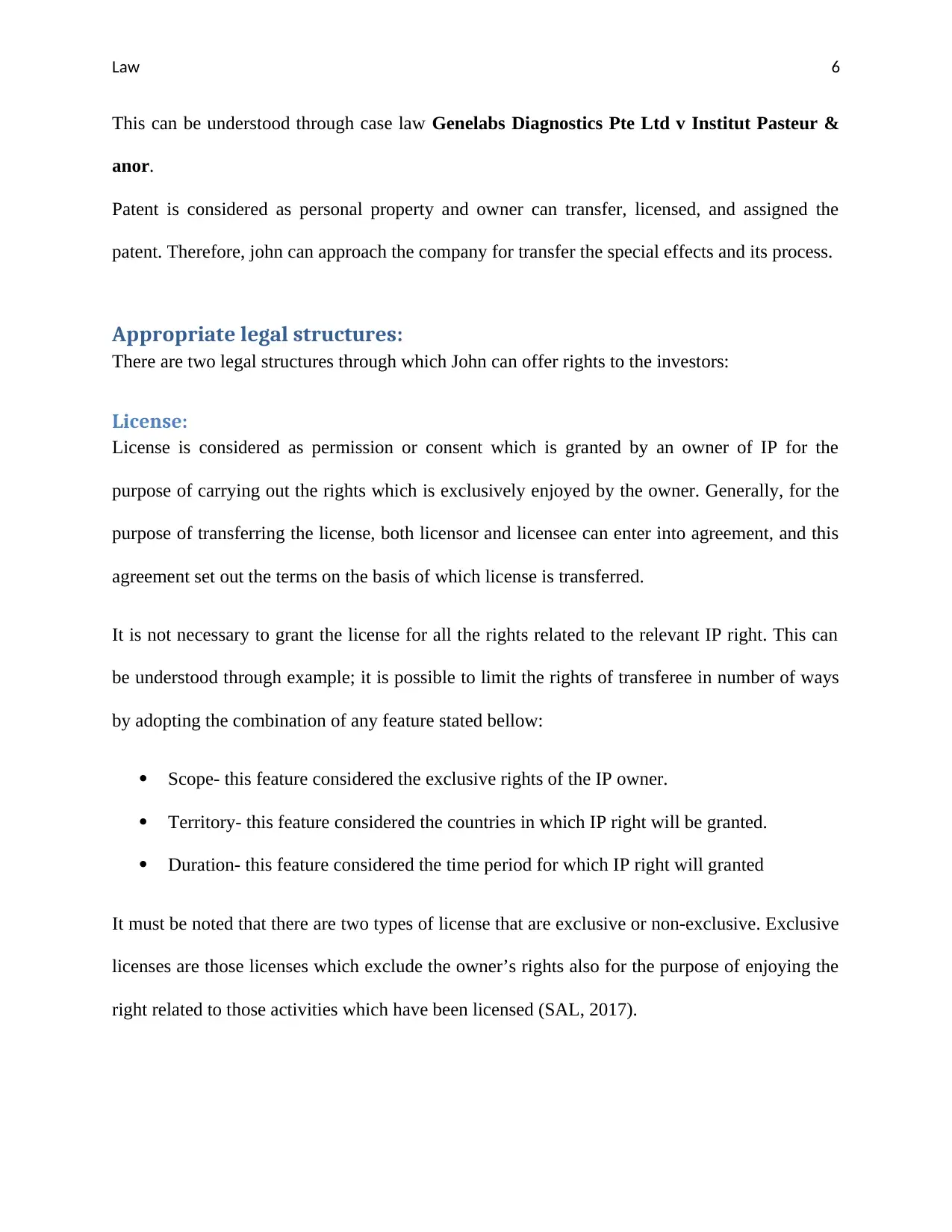
Law 6
This can be understood through case law Genelabs Diagnostics Pte Ltd v Institut Pasteur &
anor.
Patent is considered as personal property and owner can transfer, licensed, and assigned the
patent. Therefore, john can approach the company for transfer the special effects and its process.
Appropriate legal structures:
There are two legal structures through which John can offer rights to the investors:
License:
License is considered as permission or consent which is granted by an owner of IP for the
purpose of carrying out the rights which is exclusively enjoyed by the owner. Generally, for the
purpose of transferring the license, both licensor and licensee can enter into agreement, and this
agreement set out the terms on the basis of which license is transferred.
It is not necessary to grant the license for all the rights related to the relevant IP right. This can
be understood through example; it is possible to limit the rights of transferee in number of ways
by adopting the combination of any feature stated bellow:
Scope- this feature considered the exclusive rights of the IP owner.
Territory- this feature considered the countries in which IP right will be granted.
Duration- this feature considered the time period for which IP right will granted
It must be noted that there are two types of license that are exclusive or non-exclusive. Exclusive
licenses are those licenses which exclude the owner’s rights also for the purpose of enjoying the
right related to those activities which have been licensed (SAL, 2017).
This can be understood through case law Genelabs Diagnostics Pte Ltd v Institut Pasteur &
anor.
Patent is considered as personal property and owner can transfer, licensed, and assigned the
patent. Therefore, john can approach the company for transfer the special effects and its process.
Appropriate legal structures:
There are two legal structures through which John can offer rights to the investors:
License:
License is considered as permission or consent which is granted by an owner of IP for the
purpose of carrying out the rights which is exclusively enjoyed by the owner. Generally, for the
purpose of transferring the license, both licensor and licensee can enter into agreement, and this
agreement set out the terms on the basis of which license is transferred.
It is not necessary to grant the license for all the rights related to the relevant IP right. This can
be understood through example; it is possible to limit the rights of transferee in number of ways
by adopting the combination of any feature stated bellow:
Scope- this feature considered the exclusive rights of the IP owner.
Territory- this feature considered the countries in which IP right will be granted.
Duration- this feature considered the time period for which IP right will granted
It must be noted that there are two types of license that are exclusive or non-exclusive. Exclusive
licenses are those licenses which exclude the owner’s rights also for the purpose of enjoying the
right related to those activities which have been licensed (SAL, 2017).
⊘ This is a preview!⊘
Do you want full access?
Subscribe today to unlock all pages.

Trusted by 1+ million students worldwide
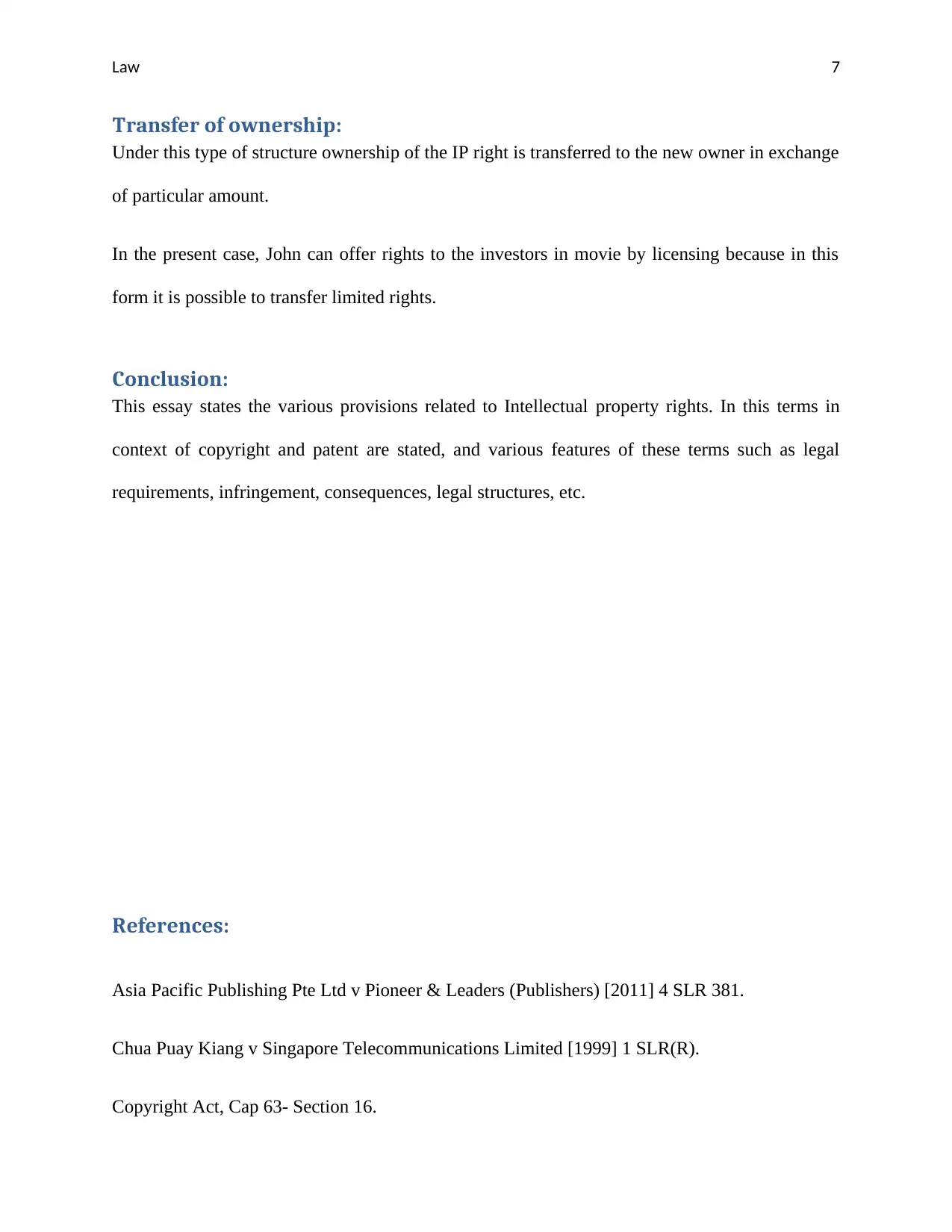
Law 7
Transfer of ownership:
Under this type of structure ownership of the IP right is transferred to the new owner in exchange
of particular amount.
In the present case, John can offer rights to the investors in movie by licensing because in this
form it is possible to transfer limited rights.
Conclusion:
This essay states the various provisions related to Intellectual property rights. In this terms in
context of copyright and patent are stated, and various features of these terms such as legal
requirements, infringement, consequences, legal structures, etc.
References:
Asia Pacific Publishing Pte Ltd v Pioneer & Leaders (Publishers) [2011] 4 SLR 381.
Chua Puay Kiang v Singapore Telecommunications Limited [1999] 1 SLR(R).
Copyright Act, Cap 63- Section 16.
Transfer of ownership:
Under this type of structure ownership of the IP right is transferred to the new owner in exchange
of particular amount.
In the present case, John can offer rights to the investors in movie by licensing because in this
form it is possible to transfer limited rights.
Conclusion:
This essay states the various provisions related to Intellectual property rights. In this terms in
context of copyright and patent are stated, and various features of these terms such as legal
requirements, infringement, consequences, legal structures, etc.
References:
Asia Pacific Publishing Pte Ltd v Pioneer & Leaders (Publishers) [2011] 4 SLR 381.
Chua Puay Kiang v Singapore Telecommunications Limited [1999] 1 SLR(R).
Copyright Act, Cap 63- Section 16.
Paraphrase This Document
Need a fresh take? Get an instant paraphrase of this document with our AI Paraphraser
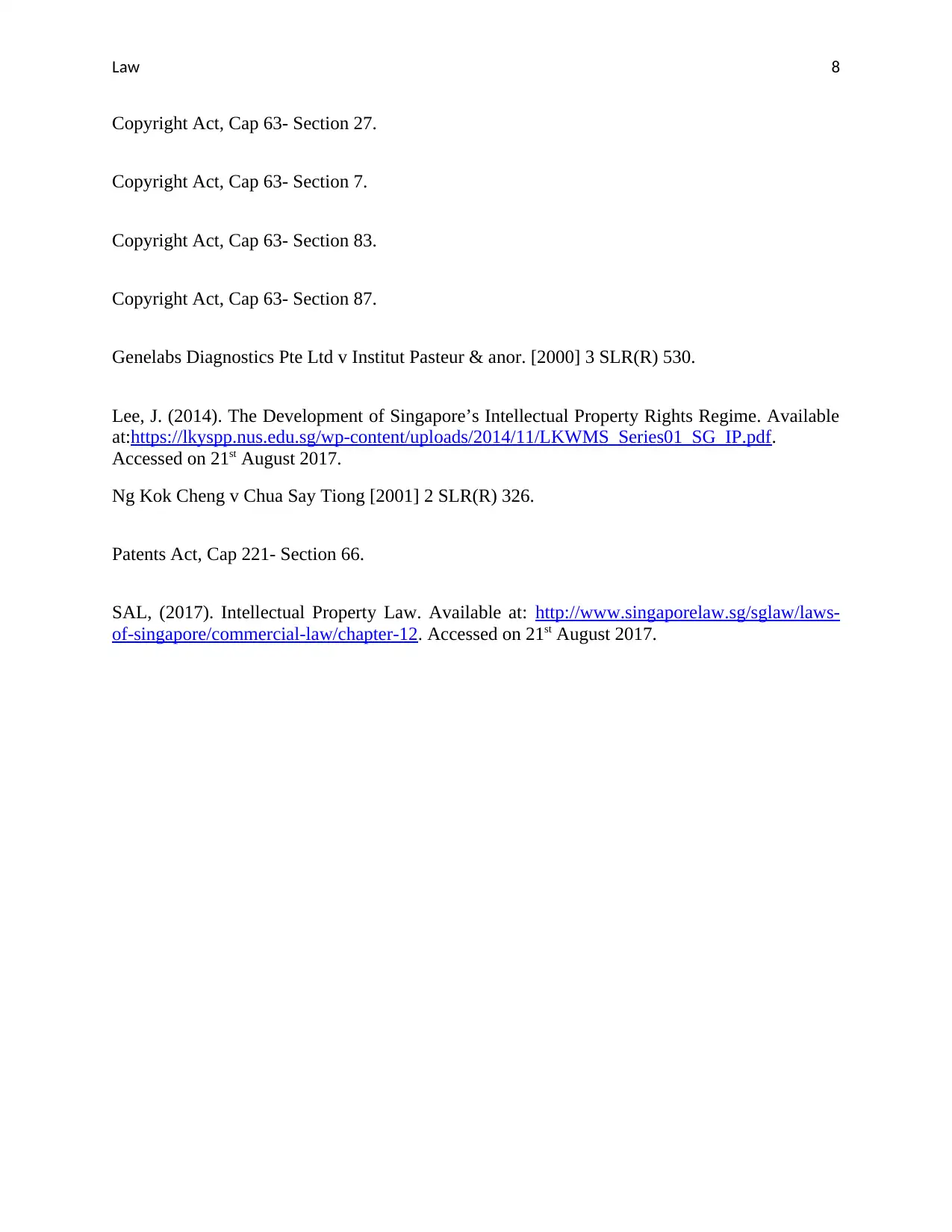
Law 8
Copyright Act, Cap 63- Section 27.
Copyright Act, Cap 63- Section 7.
Copyright Act, Cap 63- Section 83.
Copyright Act, Cap 63- Section 87.
Genelabs Diagnostics Pte Ltd v Institut Pasteur & anor. [2000] 3 SLR(R) 530.
Lee, J. (2014). The Development of Singapore’s Intellectual Property Rights Regime. Available
at:https://lkyspp.nus.edu.sg/wp-content/uploads/2014/11/LKWMS_Series01_SG_IP.pdf.
Accessed on 21st August 2017.
Ng Kok Cheng v Chua Say Tiong [2001] 2 SLR(R) 326.
Patents Act, Cap 221- Section 66.
SAL, (2017). Intellectual Property Law. Available at: http://www.singaporelaw.sg/sglaw/laws-
of-singapore/commercial-law/chapter-12. Accessed on 21st August 2017.
Copyright Act, Cap 63- Section 27.
Copyright Act, Cap 63- Section 7.
Copyright Act, Cap 63- Section 83.
Copyright Act, Cap 63- Section 87.
Genelabs Diagnostics Pte Ltd v Institut Pasteur & anor. [2000] 3 SLR(R) 530.
Lee, J. (2014). The Development of Singapore’s Intellectual Property Rights Regime. Available
at:https://lkyspp.nus.edu.sg/wp-content/uploads/2014/11/LKWMS_Series01_SG_IP.pdf.
Accessed on 21st August 2017.
Ng Kok Cheng v Chua Say Tiong [2001] 2 SLR(R) 326.
Patents Act, Cap 221- Section 66.
SAL, (2017). Intellectual Property Law. Available at: http://www.singaporelaw.sg/sglaw/laws-
of-singapore/commercial-law/chapter-12. Accessed on 21st August 2017.
1 out of 8
Related Documents
Your All-in-One AI-Powered Toolkit for Academic Success.
+13062052269
info@desklib.com
Available 24*7 on WhatsApp / Email
![[object Object]](/_next/static/media/star-bottom.7253800d.svg)
Unlock your academic potential
Copyright © 2020–2025 A2Z Services. All Rights Reserved. Developed and managed by ZUCOL.




